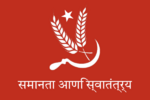Nabiyan National Liberation Front: Difference between revisions
m (→Leaders) |
|||
| Line 69: | Line 69: | ||
|- bgcolor=#EEEEEE | |- bgcolor=#EEEEEE | ||
!rowspan=2 style="background:#000000; color:white;"|2 | !rowspan=2 style="background:#000000; color:white;"|2 | ||
|rowspan=2| | |rowspan=2|[[File:Sardar patel (cropped).jpg|80px]] | ||
|rowspan=2|'''Rahul Rajavade'''<br>(1865-1941) | |rowspan=2|'''Rahul Rajavade'''<br>(1865-1941) | ||
|14 February 1938 | |14 February 1938 | ||
| Line 76: | Line 76: | ||
|style="background:#000000; color:white;"|Nationalist | |style="background:#000000; color:white;"|Nationalist | ||
|- | |- | ||
|colspan=5 align=left| {{small|}} | |colspan=5 align=left| {{small|Rahul Rajavade was the leader of the Nabiyan Nationalist Party from 1932 until his death in 1941. Rajavade was an early leader of the Nabiyan independence movement having been educated overseas in Rythene. His leadership proved integral to the formation of the united National Liberation Front where he served as leader as a part of the Leadership council and sole President from 1938 to 1941. Rajavade organised the Sindhu uprising in 1940 in coordination with Songha forces which saw Rythenean colonial forces faced with a popular uprising. Rajavade died at the age of 76 of suspected cancer. He was replacec by his deputy Shyam Pandit.}} | ||
|- bgcolor=#EEEEEE | |- bgcolor=#EEEEEE | ||
!rowspan=2 style="background:#000000; color:white;"|3 | !rowspan=2 style="background:#000000; color:white;"|3 | ||
|rowspan=2| | |rowspan=2|[[File:Bihar Vibhuti Dr Anugrah Narayan Sinha,first Bihar Dy Chief Minister.jpg|80px]] | ||
|rowspan=2|'''Shyam Pandit'''<br>(1873-1967) | |rowspan=2|'''Shyam Pandit'''<br>(1873-1967) | ||
|2 August 1941 | |2 August 1941 | ||
| Line 86: | Line 86: | ||
|style="background:#000000; color:white;"|Nationalist | |style="background:#000000; color:white;"|Nationalist | ||
|- | |- | ||
|colspan=5 align=left| {{small|}} | |colspan=5 align=left| {{small|Shyam Pandit took over leadership of the Nationalist Party and the National Liberation Front following the death of Rajavade. Pandit held the leadership of the front for a total of 196 days until the Nationalists 4 year term expired. Pandit continued the hard-line approach of his predicessor, working with Songha forces to fight for Nabiyan independence. Pandit would be replaced as leader of the Nationalist Party the following year by Rohit Gadkari.}} | ||
|- bgcolor=#EEEEEE | |- bgcolor=#EEEEEE | ||
!rowspan=2 style="background:green; color:white;"|4 | !rowspan=2 style="background:green; color:white;"|4 | ||
|rowspan=2| | |rowspan=2|[[File:President Fakhruddin Ali Ahmed.jpg|80px]] | ||
|rowspan=2|'''Abhijeet Phatak'''<br>(1882-1977) | |rowspan=2|'''Abhijeet Phatak'''<br>(1882-1977) | ||
|14 February 1942 | |14 February 1942 | ||
| Line 96: | Line 96: | ||
|style="background:green; color:white;"|Republican | |style="background:green; color:white;"|Republican | ||
|- | |- | ||
|colspan=5 align=left| {{small|}} | |colspan=5 align=left| {{small|Abhijeet Phatak took over leadership of the National Liberation Front in 1942 in the midst of the Second Great War. Compared to his predicessors Phatak took a more moderate stance, moving towards greater negotiation with colonial authorities over armed resistance, a factor which caused considerable tensions with the other parties within the coalition. Such divisions significantly reduced the influence of the NLF over the Nabiyan independence movement, leading the Senapati to gain control over the Rythenean colonial army and a significant portion of the country's provinces as Rythene retreated from Nabiya.}} | ||
|- bgcolor=#EEEEEE | |- bgcolor=#EEEEEE | ||
!rowspan=2 style="background:red; color:white;"|5 | !rowspan=2 style="background:red; color:white;"|5 | ||
Revision as of 23:58, 31 July 2024
This article is incomplete because it is pending further input from participants, or it is a work-in-progress by one author. Please comment on this article's talk page to share your input, comments and questions. Note: To contribute to this article, you may need to seek help from the author(s) of this page. |
Nabiyan National Liberation Front नबियान नॅशनल लिबरेशन फ्रंट Nabiyāna nĕśanala libarēśana phraṇṭa | |
|---|---|
 | |
| Leader | Ravi Goyal |
| Deputy Leader | Alia Bhagat |
| Founded | 1934 |
| Ideology | Revolutionary Socialism Anarchism Dhamdherism |
| Political position | Far-left |
The Nabiyan National Liberation Front (Thrakur: नबियान नॅशनल लिबरेशन फ्रंट, Nabiyāna nĕśanala libarēśana phraṇṭa) or simply the NLF, is a revolutionary, socialist political party and rebel group operating within Nabiya. Formed by 1934 as a union of the Nabiyan Communist, Nationalist and Republican parties as an attempt to fight for Nabiyan independence against Rythene and Tyrnica the group has since evolved into a anarcho-socialist revolutionary group occupying areas of southern Nabiya and current engaged in an on-and-off conflict against the Senapati-led government of the Arani Empire.
Organisation
History
Ideology
Administration
Leaders
The Leadership of the National Liberation Front has evolved over time with the type of leadership and method of election changing based on amendments to the party's constitution. Originally, the NLF had no designating leader and instead operated with a leadership council made up of all three independent party leaders. Each leader would share authority over the group with any decisions or amendments to the party's constitution requiring unanimous agreement between all three.
As the independence struggle deepened however this proved unworkable leading the constitution to be amended to include a rotating presidency. Under this system the President of the NLF would serve a 4-year term which would rotate between candidates from the Nationalist Party, Nabiyan Republican Party and Communist Party of Nabiya. This system of a rotating presidency existed between 1938 and 1952 when it was replaced by a system of election by committee from all parties in the coalition without any system of rotation. This amendment greatly benefitted the Communist party which by this point had gained almost complete control over the party committee and membership due to entryist tactics which largely displaced the influence of the Nationalist and Republican groups. Under the current system, the party presidency has evolved from periods of almost dictatorial control during the 1970s and 80s, to the more democratic system seen under the modern anarcho-socialist party today.



